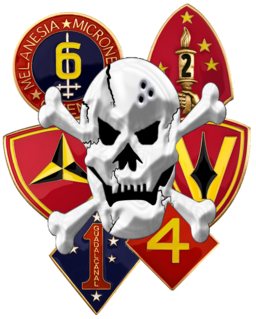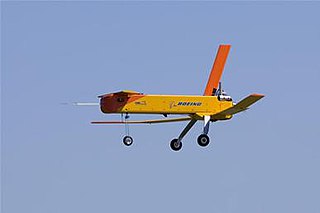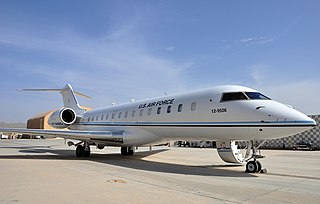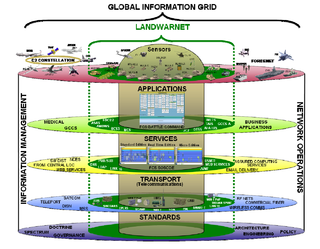Full-spectrum dominance also known as full-spectrum superiority, is a military entity's achievement of control over all dimensions of the battlespace, effectively possessing an overwhelming diversity of resources in such areas as terrestrial, aerial, maritime, subterranean, extraterrestrial, psychological, and bio- or cyber-technological warfare.
Fires is the related tasks and systems that provide collective and coordinated use of Army indirect fires, air and missile defense, and joint fires through the targeting process. Alternatively, it can be defined as the use of weapon systems to create a specific lethal or nonlethal effect on a target.
Network-centric warfare, also called network-centric operations or net-centric warfare, is a military doctrine or theory of war that seeks to translate an information advantage, enabled in part by information technology, into a competitive advantage through the robust computer networking of well informed geographically dispersed forces. It is based on ideas of marshal of USSR Nikolai Ogarkov, set out by him in early 1980s. It was pioneered by the United States Department of Defense in the 1990s.

The Global Information Grid (GIG) is a network of information transmission and processing maintained by the United States Department of Defense. More descriptively, it is a worldwide network of information transmission, of associated processes, and of personnel serving to collect, process, safeguard, transmit, and manage this information. It is an all-encompassing communications project of the United States Department of Defense. The GIG makes this immediately available to military personnel, to those responsible for military politics, and for support personnel. It includes all infrastructure, bought or loaned, of communications, electronics, informatics, and security. It is the most visible manifestation of network-centric warfare. It is the combination of technology and human activity that enables warfighters to access information on demand.

The United States Marine Corps Reconnaissance Battalions are the Special Operations Capable reconnaissance assets of Marine Air-Ground Task Force that provide division-level ground and amphibious reconnaissance to the Ground Combat Element within the United States Marine Corps. Division reconnaissance teams are employed to observe and report on enemy activity and other information of military significance in close operations. The Military Occupational Specialty code for Reconnaissance Marine is 0321.
Joint warfare is a military doctrine which places priority on the integration of the various service branches of a state's armed forces into one unified command. Joint warfare is in essence a form of combined arms warfare on a larger, national scale, in which complementary forces from a state's army, navy, air, and special forces are meant to work together in joint operations, rather than planning and executing military operations separate from each other.
Infosphere, analogous to a biosphere, is a metaphysical realm of information, data, knowledge, and communication, populated by informational entities called inforgs.
Battlespace or battle-space is a term used to signify a unified military strategy to integrate and combine armed forces for the military theatre of operations, including air, information, land, sea, cyber and outer space to achieve military goals. It includes the environment, factors, and conditions that must be understood to successfully apply combat power, protect the force, or complete the mission. This includes enemy and friendly armed forces, infrastructure, weather, terrain, and the electromagnetic spectrum within the operational areas and areas of interest.

The Persistent Munition Technology Demonstrator or PMTD is an unmanned aerial vehicle (UAV) developed and produced by the Advanced Weapons and Missile Systems division of Boeing as a test bed in order to further develop and flight test various UAV technologies. It has also been referred to as the Dominator. The PMTD weighs 60 pounds (27 kg), has a 12 feet (3.7 m) wingspan and is powered by a single piston engine driving a pusher propeller. It was first flown in April, 2006, at Vandalia Municipal Airport, Vandalia, Illinois.

Command and control is a "set of organizational and technical attributes and processes ... [that] employs human, physical, and information resources to solve problems and accomplish missions" to achieve the goals of an organization or enterprise, according to a 2015 definition by military scientists Marius Vassiliou, David S. Alberts, and Jonathan R. Agre. The term often refers to a military system.

The Global Area Reference System (GARS) is a standardized geospatial reference system developed by the National Geospatial-Intelligence Agency (NGA) for use across the United States Department of Defense. Under the Chairman of the Joint Chiefs of Staff Instruction CJCSI 3900.01C dated 30 June 2007, GARS was adopted for use by the US DoD as "the “area-centric” counterpart to the “point-centric” MGRS". It uses the WGS 1984 Datum and is based on lines of longitude (LONG) and latitude (LAT). It is intended to provide an integrated common frame of reference for joint force situational awareness to facilitate air-to-ground coordination, deconfliction, integration, and synchronization. This area reference system provides a common language between the components and simplifies communications. GARS is primarily designed as a battlespace management tool and not to be used for navigation or targeting.

The Battlefield Airborne Communications Node (BACN) is a United States Air Force (USAF) airborne communications relay and gateway system carried by the unmanned EQ-4B and the manned Bombardier E-11A aircraft. BACN enables real-time information flow across the battlespace between similar and dissimilar tactical data link and voice systems through relay, bridging, and data translation in line-of-sight and beyond-line-of-sight situations. Its ability to translate between dissimilar communications systems allows them to interoperate without modification.
Thales-Raytheon Systems Company LLC is an aerospace and defence company co-headquartered in Massy, Paris, France and Fullerton, California, United States. It is operated as a 50:50 joint venture between Raytheon Technologies and Thales Group.
Area of responsibility (AOR) is a pre-defined geographic region assigned to Combatant commanders of the Unified Command Plan (UCP), that are used to define an area with specific geographic boundaries where they have the authority to plan and conduct operations; for which a force, or component commander bears a certain responsibility. The term may also be used in other countries worldwide but it originated within the United States Armed Forces. This system is designed to allow a single commander to exercise command and control of all military forces in the AOR, regardless of their branch of service.

The FCS Network - Brigade Combat Team (BCT) Network consists of five layers that combine to provide seamless delivery of data to forward-deployed Army units.

The under secretary of defense (comptroller)/chief financial officer, abbreviated USD(C)/CFO, is a high level civilian official in the United States Department of Defense. The Under Secretary of Defense (Comptroller) is the principal staff assistant and adviser to both the Secretary of Defense and the Deputy Secretary of Defense for all budgetary and fiscal matters, including the development and execution of the Defense Department's annual budget.
Within the United States Department of Defense, the Joint Capability Areas (JCA) are a standardized set of United States military definitions that cover the complete range of military activities. The system was initially established in May 2005 by the United States Department of Defense Joint Staff with input from each of the services, designed to begin "a new framework that paves the way for side-by-side comparisons of service contributions to joint warfighting and a tool that will assist decision-makers in deciding whether to move resources between service budgets."

USA-273, also known as SBIRS GEO-3, is an United States military satellite and part of the Space-Based Infrared System (SBIRS).

USA-282, also known as SBIRS GEO-4, is an United States military satellite and part of the Space-Based Infrared System.









